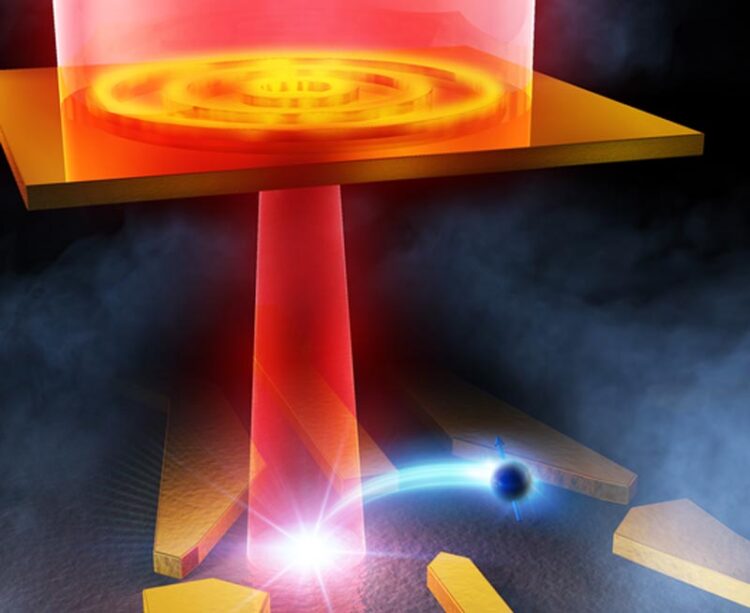A nanoantenna for long-distance, ultra-secure communication

Conceptual illustration of efficient illumination of photons to semiconductor lateral quantum dots, by using a surface plasmon antenna and excitation of electrons in the quantum dots.
Copyright @ 2021 Oiwa lab. All Rights Reserved
Researchers from Osaka University have improved the transfer efficiency between quantum information carriers, in a manner that’s based on well-established nanoscience and is compatible with upcoming advanced communication technologies.
Information storage and transfer in the manner of simple ones and zeros—as in today’s classical computer technologies—is insufficient for quantum technologies under development. Now, researchers from Japan have fabricated a nanoantenna that will help bring quantum information networks closer to practical use.
In a study recently published in Applied Physics Express, researchers from Osaka University and collaborating partners have substantially enhanced photon-to-electron conversion through a metal nanostructure, which is an important step forward in the development of advanced technologies for sharing and processing data.
Classical computer information is based on simple on/off readouts. It’s straightforward to use a technology known as a repeater to amplify and retransmit this information over long distances. Quantum information is based on comparatively more complex and secure readouts, such as photon polarization and electron spin. Semiconductor nanoboxes known as quantum dots are materials that researchers have proposed for storing and transferring quantum information. However, quantum repeater technologies have some limitations—for example, current ways to convert photon-based information to electron-based information are highly inefficient. Overcoming this information conversion and transfer challenge is what the researchers at Osaka University aimed to address.
“The efficiency of converting single photons into single electrons in gallium arsenide quantum dots—common materials in quantum communication research—is currently too low,” explains lead author Rio Fukai. “Accordingly, we designed a nanoantenna—consisting of ultra-small concentric rings of gold—to focus light onto a single quantum dot, resulting in a voltage readout from our device.”
The researchers enhanced photon absorption by a factor of up to 9, compared with not using the nanoantenna. After illuminating a single quantum dot, most of the photogenerated electrons weren’t trapped there, and instead accumulated in impurities or other locations in the device. Nevertheless, these excess electrons gave a minimal voltage readout that was readily distinguished from that generated by the quantum dot electrons, and thus didn’t disrupt the device’s intended readout.
“Theoretical simulations indicate that we can improve the photon absorption by up to a factor of 25,” says senior author Akira Oiwa. “Improving the alignment of the light source and more precisely fabricating the nanoantenna are ongoing research directions in our group.”
These results have important applications. Researchers now have a means of using well-established nano-photonics to advance the prospects of upcoming quantum communication and information networks. By using abstract physics properties such as entanglement and superposition, quantum technology could provide unprecedented information security and data processing in the coming decades.
The article, “Detection of photogenerated single electrons in a lateral quantum dot with a surface plasmon antenna,” was published in Applied Physics Express at DOI: https://doi.org/10.35848/1882-0786/ac336d
About Osaka University
Osaka University was founded in 1931 as one of the seven imperial universities of Japan and is now one of Japan’s leading comprehensive universities with a broad disciplinary spectrum. This strength is coupled with a singular drive for innovation that extends throughout the scientific process, from fundamental research to the creation of applied technology with positive economic impacts. Its commitment to innovation has been recognized in Japan and around the world, being named Japan’s most innovative university in 2015 (Reuters 2015 Top 100) and one of the most innovative institutions in the world in 2017 (Innovative Universities and the Nature Index Innovation 2017). Now, Osaka University is leveraging its role as a Designated National University Corporation selected by the Ministry of Education, Culture, Sports, Science and Technology to contribute to innovation for human welfare, sustainable development of society, and social transformation.
Website: https://resou.osaka-u.ac.jp/en
Journal: Applied Physics Express
DOI: 10.35848/1882-0786/ac336d
Method of Research: Experimental study
Subject of Research: Not applicable
Article Title: Detection of photogenerated single electrons in a lateral quantum dot with a surface plasmon antenna
Media Contact
Saori Obayashi
Osaka University
gi-strategy@cgin.osaka-u.ac.jp
Office: 81-661-055-886
Original Source
All latest news from the category: Information Technology
Here you can find a summary of innovations in the fields of information and data processing and up-to-date developments on IT equipment and hardware.
This area covers topics such as IT services, IT architectures, IT management and telecommunications.
Newest articles

Innovative 3D printed scaffolds offer new hope for bone healing
Researchers at the Institute for Bioengineering of Catalonia have developed novel 3D printed PLA-CaP scaffolds that promote blood vessel formation, ensuring better healing and regeneration of bone tissue. Bone is…

The surprising role of gut infection in Alzheimer’s disease
ASU- and Banner Alzheimer’s Institute-led study implicates link between a common virus and the disease, which travels from the gut to the brain and may be a target for antiviral…

Molecular gardening: New enzymes discovered for protein modification pruning
How deubiquitinases USP53 and USP54 cleave long polyubiquitin chains and how the former is linked to liver disease in children. Deubiquitinases (DUBs) are enzymes used by cells to trim protein…



